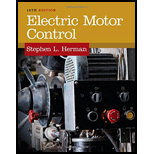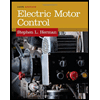
Electric Motor Control
10th Edition
ISBN: 9781133702818
Author: Herman
Publisher: CENGAGE L
expand_more
expand_more
format_list_bulleted
Concept explainers
Question
Chapter 23, Problem 5SQ
To determine
Use the selector switch with forward, reverse, and stop push buttons to draw an elementary control diagram of a reversing starter.
Expert Solution & Answer
Trending nowThis is a popular solution!

Students have asked these similar questions
Please answer all
find the inverse Laplace transform of X(s)=
i) Re[s]> 3
ii) Re[s]<1
s+5
for
(s-1)(s-2)(s-3)
iii) 1
For R1, what is the resistance in kΩ?
For R1, what the current in mA?
For R1, what is the voltage in V?
For R1, what is the power in W?
For R2, what is the resistance in kΩ?
For R2, what the current in mA?
For R2, what is the voltage in V?
For R2, what is the power in W?
For R3, what is the resistance in kΩ?
For R3, what the current in mA?
For R3, what is the voltage in V?
For R3, what is the power in W?
For R4, what is the resistance in kΩ?
For R4, what the current in mA?
For R4, what is the voltage in V?
For R4, what is the power in W?
For R5, what is the resistance in kΩ?
For R5, what the current in mA?
For R5, what is the voltage in V?
For R5, what is the power in W?
What is the total resistance in Ω?
What is the total current in mA?
What is the total voltage in V?
What is the total power in W?
Knowledge Booster
Learn more about
Need a deep-dive on the concept behind this application? Look no further. Learn more about this topic, electrical-engineering and related others by exploring similar questions and additional content below.Similar questions
- Calculate de currents IaA, IbB and IcCarrow_forward7.48 Determine the Thevenin equivalent of the circuit inFig. P7.48 at terminals (a,b), given thatVs(t) = 12cos 2500t V,Is(t) = 0.5cos(2500t −30◦) A.arrow_forward1. In the following closed-loop system, a PD controller of the form K(s + 5) is used. Design the gain K such that the system achieves an overshoot of 16%. Calculate the settling time and peak time for the PD controlled system. Compensator R(s) + E(s) Plant 1 C(s) K(s+Zc) (s+1)(s+2)(s+5)arrow_forward
- Find Voarrow_forward3. Use MATLAB to generate the Nyquist plot for the following system. Then, apply the Nyquist stability criterion to determine the range of K values that ensure the stability of the closed-loop system. R(s)+ K C(s) (s+2) 1 (s + 4)(s+6)arrow_forward4. Please find the stability margins from the following Bode diagrams. Bode Diagram Phase (deg) Magnitude (dB) 50 -100 -90 -135 -180 -270 10" 10° Frequency (rad/sec) 10'arrow_forward
arrow_back_ios
SEE MORE QUESTIONS
arrow_forward_ios
Recommended textbooks for you

 Electricity for Refrigeration, Heating, and Air C...Mechanical EngineeringISBN:9781337399128Author:Russell E. SmithPublisher:Cengage Learning
Electricity for Refrigeration, Heating, and Air C...Mechanical EngineeringISBN:9781337399128Author:Russell E. SmithPublisher:Cengage Learning


Electricity for Refrigeration, Heating, and Air C...
Mechanical Engineering
ISBN:9781337399128
Author:Russell E. Smith
Publisher:Cengage Learning